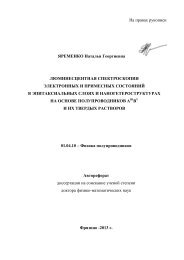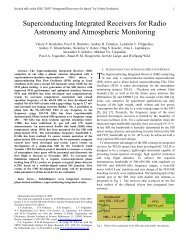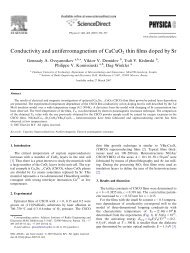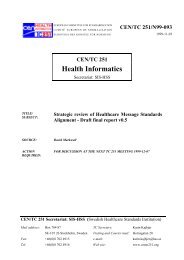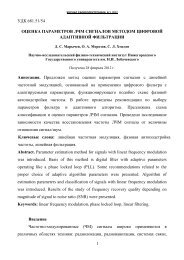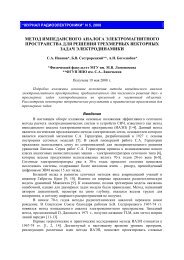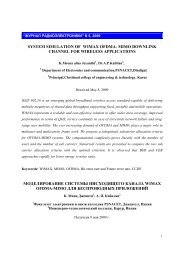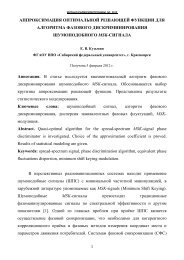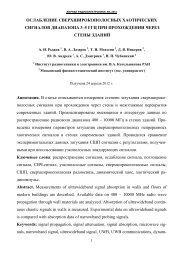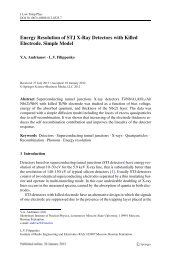A superconducting phase-locked local oscillator for a ... - Cplire.ru
A superconducting phase-locked local oscillator for a ... - Cplire.ru
A superconducting phase-locked local oscillator for a ... - Cplire.ru
Create successful ePaper yourself
Turn your PDF publications into a flip-book with our unique Google optimized e-Paper software.
INSTITUTE OF PHYSICS PUBLISHING SUPERCONDUCTOR SCIENCE AND TECHNOLOGY<br />
Supercond. Sci. Technol. 17 (2004) S127–S131 PII: S0953-2048(04)72363-5<br />
A<strong>superconducting</strong> <strong>phase</strong>-<strong>locked</strong> <strong>local</strong><br />
<strong>oscillator</strong> <strong>for</strong> a submillimetre integrated<br />
receiver<br />
VPKoshelets 1,3 ,SVShitov 1,3 ,LVFilippenko 1 ,PNDmitriev 1 ,<br />
ABErmakov 1,3 ,ASSobolev 1 ,MYuTorgashin 1 ,ALPankratov 2 ,<br />
VVKurin 2 ,PYagoubov 3 and R Hoogeveen 3<br />
1 Institute of Radio Engineering and Electronics (IREE), Mokhovaya 11, Bldg. 7, Moscow,<br />
125009, Russia<br />
2 Institute <strong>for</strong> Physics of Microst<strong>ru</strong>cture (IPM), Ulyanov 46, GSP-105, Nizhny Novgorod,<br />
603600, Russia<br />
3 National Institute <strong>for</strong> Space Research (SRON), Landleven, 12, PO Box 800, Groningen,<br />
9700 Av., The Netherlands<br />
Received 29 September 2003<br />
Published 19 Feb<strong>ru</strong>ary 2004<br />
Online at stacks.iop.org/SUST/17/S127 (DOI: 10.1088/0953-2048/17/5/007)<br />
Abstract<br />
Comprehensive measurements of the flux flow <strong>oscillator</strong> (FFO) radiation<br />
linewidth are per<strong>for</strong>med using an integrated harmonic SIS mixer; the FFO<br />
linewidth and spectral line profile are compared to a theory. An essential<br />
dependence of the FFO linewidth on frequency is found; a possible<br />
explanation is proposed. The results of the numerical solution of the<br />
perturbed sine–Gordon equation qualitatively confirm this assumption. To<br />
optimize the FFO design, the influence of the FFO parameters on the<br />
radiation linewidth is studied. A novel FFO design at a moderate current<br />
density has resulted in a free-<strong>ru</strong>nning FFO linewidth of about 10 MHz in the<br />
flux flow regime up to 712 GHz, limited only by the gap frequency of Nb.<br />
This relatively narrow free-<strong>ru</strong>nning linewidth (along with implementation of<br />
awide-band <strong>phase</strong> locking loop system) allows continuous <strong>phase</strong> locking of<br />
the FFO in the wide frequency range of 500–710 GHz. These results are the<br />
basis <strong>for</strong> the development of a 550–650 GHz integrated receiver <strong>for</strong> the<br />
terahertz limb sounder (TELIS) intended <strong>for</strong> atmosphere study and<br />
scheduled to fly on a balloon in 2005. We report here also on the design of<br />
the second generation of the <strong>phase</strong>-<strong>locked</strong> <strong>superconducting</strong> integrated<br />
receiver chip <strong>for</strong> TELIS.<br />
(Some figures in this article are in colour only in the electronic version)<br />
1. Introduction<br />
At present a Josephson flux flow <strong>oscillator</strong> (FFO) [1] appears<br />
to be the most developed <strong>superconducting</strong> <strong>local</strong> <strong>oscillator</strong> <strong>for</strong><br />
integration with an SIS mixer in a single-chip submillimetre<br />
wave receiver [2]. A <strong>superconducting</strong> integrated receiver<br />
(SIR) [2] comprises in one chip a planar antenna and an<br />
SIS mixer, pumped by an integrated <strong>superconducting</strong> <strong>local</strong><br />
<strong>oscillator</strong> (LO). The concept of an SIR has been experimentally<br />
proven: aDSB receiver noise temperature below 100 K has<br />
been demonstrated around 500 GHz; a compact imaging array<br />
of nine SIRs has been developed and tested [2, 3]. The<br />
frequency resolution of a heterodyne spectrometer is one of the<br />
major parameters <strong>for</strong> a practical application. In order to obtain<br />
the required resolution (of at least one part per million) the<br />
<strong>local</strong> <strong>oscillator</strong> must be <strong>phase</strong>-<strong>locked</strong> to an external reference.<br />
To ensure the <strong>phase</strong> locking, the free-<strong>ru</strong>nning linewidth of the<br />
FFO has to be well below an effective regulation bandwidth of<br />
the PLL (of about 10 MHz).<br />
Detailed measurements of the FFO linewidth were<br />
per<strong>for</strong>med in a wide frequency range up to 700 GHz using a<br />
novel experimental technique based on an integrated harmonic<br />
mixer [4]. A Lorentzian shape of the FFO line has been<br />
observed both at higher voltages on the flux flow step (FFS)<br />
0953-2048/04/050127+05$30.00 © 2004 IOP Publishing Ltd Printed in the UK S127
VPKoshelets et al<br />
Figure 1. Thedependence of the FFO linewidth on the oscillation frequency measured <strong>for</strong> FFOs of the same design (see the inset), but<br />
fabricated from three trilayers with different current densities, Jc. Thelinewidth is measured at constant bias current, while the FFO<br />
frequency (voltage) is tuned by the magnetic field (by the control line current).<br />
and at lower voltages in the resonant regime on the Fiske steps<br />
(FSs) [5]. This means that the free-<strong>ru</strong>nning (‘natural’) FFO<br />
linewidth in all operational regimes is determined by the wideband<br />
thermal fluctuations and the shot noise. This is different<br />
from the case <strong>for</strong> many traditional microwave <strong>oscillator</strong>s where<br />
the ‘natural’ linewidth is very small and the observed linewidth<br />
can be attributed mainly to external fluctuations. It was<br />
found [3–6] that the free-<strong>ru</strong>nning FFO linewidth, δ f ,exceeds<br />
theoretical estimations made <strong>for</strong> a lumped tunnel Josephson<br />
junction. To explain the experimentally measured dependence<br />
of the FFO linewidth, an additional term proportional to<br />
the differential resistance on the control line current, R CL<br />
d<br />
(producing a magnetic field <strong>for</strong> the FFO operation), has been<br />
introduced to the noise model of the FFO [5–7]: δ f =<br />
(2π/� 2 0 )(Rd + K ∗ R CL<br />
d )2 Si(0); where Si(0) is the power<br />
density of the low frequency current fluctuations, Rd is the<br />
differential resistance on the bias current. Recently a physical<br />
reason <strong>for</strong> such an additional term has been proposed [8]. The<br />
solution is based on the assumption that part of the DC bias<br />
current creates an additional magnetic field in the junction.<br />
In this report the results of a comprehensive study of<br />
the dependence of the FFO linewidth on the voltage (FFO<br />
frequency), the current density and the FFO geometry are<br />
presented. Section 3 of the paper is devoted to the design of<br />
and test results <strong>for</strong> the SIR with a <strong>phase</strong>-<strong>locked</strong> FFO designed<br />
<strong>for</strong> TELIS.<br />
2. FFO linewidth; the dependence of the FFO<br />
frequency and current density<br />
Experimentally measured dependences of the FFO linewidth<br />
are presented in figure 1 <strong>for</strong> junctions with uni<strong>for</strong>m bias current<br />
distributions (without an ‘unbiased tail’). The ab<strong>ru</strong>pt increase<br />
of the linewidth at the FFO frequency of about 450 GHz is<br />
caused by the effect of Josephson self-coupling (JSC) [9, 10],<br />
which considerably modifies the FFO properties at voltages<br />
V ≈ VJSC = (1/3)Vgap (VJSC corresponds to 450 GHz <strong>for</strong><br />
an Nb–AlOx–Nb FFO). This increase of the intrinsic FFO<br />
linewidth due to the larger internal damping caused by the<br />
JSC effect at voltages V > VJSC significantly complicates the<br />
<strong>phase</strong> locking of the FFO.<br />
S128<br />
Jc = 8.5 kA/cm 2<br />
Jc = 5.8 kA/cm 2<br />
Jc = 4.2 kA/cm 2<br />
(a)<br />
FFO Voltage (mV)<br />
0.5 0.6 0.7 0.8 0.9 1.0 1.1 1.2 1.3 1.4 1.5<br />
0.14<br />
0.12<br />
0.10<br />
Rd, RdCL (Ohm)<br />
RdCL (Ohm)<br />
0.08<br />
0.06<br />
0.04<br />
0.02<br />
0.00<br />
0.08<br />
0.06<br />
0.04<br />
0.02<br />
Rd<br />
RdCL<br />
0.18<br />
RdCl = 0.001 + 2.73*Rd<br />
0.16 Jc=8.5kA/cm<br />
0.14<br />
0.12<br />
0.10<br />
2<br />
250 300 350 400 450 500 550 600 650 700 750<br />
(b)<br />
FFO Frequency (GHz)<br />
Ib = 30 mA<br />
Ib = 27 mA<br />
Ib = 21 mA<br />
Ib = 15 mA<br />
0.00<br />
0.00 0.02 0.04 0.06<br />
Rd (Ohm)<br />
Figure 2. Differential resistances to the bias current, Rd, and<br />
magnetic field (control line current), RCL versus the FFO frequency<br />
d<br />
(a); and the dependence of RCL d on Rd (b). Differential resistances<br />
are calculated from the voltage change �V found upon a small<br />
incrementation of two currents, �I and �Icl. Thevoltage change<br />
�V is determined by measuring the frequency of the emitted<br />
radiation.<br />
Forall current densities there is a well-defined dependence<br />
of the free-<strong>ru</strong>nning FFO linewidth on the frequency (voltage).
Normalized Rd, RdCL (a.u.)<br />
1.0<br />
0.8<br />
0.6<br />
0.4<br />
0.2<br />
CL<br />
Rd R d<br />
0.0<br />
3.0 3.5 4.0 4.5 5.0 5.5 6.0<br />
Normalized FFO Voltage (a.u.)<br />
Figure 3. Differential resistances Rd and R CL<br />
d calculated at the<br />
normalized bias current 0.3 <strong>for</strong> the junction length l = 40 and<br />
damping α = 0.05. The curves in the figure are the results of<br />
polynomial fitting to numerically calculated data.<br />
In the model [5, 6] the direct voltage dependence of the FFO<br />
linewidth is negligibly small. Since the data are taken at<br />
aconstant bias current, the variation of the linewidth with<br />
the bias voltage can be mainly attributed to changes in the<br />
differential resistance. Indeed, data in figure 2(a) demonstrate<br />
such a dependence (see also[11]); it is observed <strong>for</strong> all FFOs<br />
tested, ofvery different designs. It should also be mentioned<br />
that Rd and R CL<br />
d are bounded: their ratio is almost constant<br />
over the wide voltage range (see figure 2(b)). Presumably the<br />
dependence of Rd and R CL<br />
d on the FFO frequency (voltage)<br />
reflects the fact that introduction of an additional fluxon into<br />
thejunction requires a larger control line current as the fluxon<br />
chain gets denser. This assumption is confirmed by numerical<br />
calculations (see figure 3).<br />
It should be mentioned that the differential resistances <strong>for</strong><br />
figure 2 were obtained during FFO linewidth measurements,<br />
which enables measurement of voltage increments with<br />
accuracy better than 20 nV by observing the frequency change<br />
of the emitted radiation. Note that the results of direct DC<br />
measurements (which average data in the range of about<br />
1–2 µV) give exactly the same dependence.<br />
The results of preliminary numerical solution of the<br />
perturbed sine–Gordon equation are presented in figure 3.<br />
The dimensionless parameters are chosen to be close to the<br />
experimental ones: the length (normalized to the Josephson<br />
penetration depth)l = 40, the damping α = 0.05, the magnetic<br />
field varies from 3 to 8 (flux flow step). For so small a<br />
damping, the results of numerical calculations are ‘noisy’, so<br />
the polynomial fits to the data are presented in figure 3. As is<br />
seen from figure 3 both R CL<br />
d and Rd decrease with increase of<br />
the voltage.<br />
Data presented in figure 1 demonstrate also a considerable<br />
increase of the FFO linewidth with FFO current density. Note<br />
that bias currents <strong>for</strong> all current densities are quite similar<br />
andtheir difference cannot explain the broadening of the FFO<br />
linewidth. Again, the increase ismainlycaused by changing<br />
the differential resistance and can be quantitatively calculated<br />
from the model [5, 6]. This is confirmed by data presented<br />
in figure 4, where the experimental linewidth is normalized<br />
A<strong>superconducting</strong> <strong>phase</strong>-<strong>locked</strong> <strong>local</strong> <strong>oscillator</strong> <strong>for</strong> asub-mm integrated receiver<br />
Normalized FFO Linewidth<br />
1.6<br />
1.4<br />
1.2<br />
1.0<br />
0.8<br />
0.6<br />
; Jc = 8.5 kA/cm 2 ; K= 0.25<br />
; Jc = 5.8 kA/cm 2 ; K= 0.15<br />
; Jc = 4.2 kA/cm 2 ; K= 0.0<br />
500 550 600 650 700<br />
FFO Frequency (GHz)<br />
Figure 4. The experimental linewidth normalized to theoretical<br />
values. Calculations are based on the FFO model [5, 6] using<br />
experimentally measured values of differential resistances and<br />
currents. Linear fits to the normalized data are shown by appropriate<br />
lines.<br />
to theoretically calculated linewidth values. The linear fits to<br />
the normalized data coincide well with each other (and with<br />
the unity line) <strong>for</strong> all current densities. This proves that an<br />
additional broadening discussed in the papers [12, 13] does<br />
not play a significant role <strong>for</strong> the present FFO parameters and<br />
the linewidth can be precisely calculated using the FFO model<br />
developed [5–7]. Note that experimentally determined values<br />
of the coefficient K are used <strong>for</strong> the calculation of the FFO<br />
linewidth. This coefficient accounts <strong>for</strong> the influence of the<br />
magnetic field created by the bias current [8] by adding the<br />
product KR CL<br />
d to the measured Rd. TheK -value varies from<br />
0.35 (at small bias currents near the quasiparticle curve) down<br />
to zero (at the end of the flux flow step) <strong>for</strong> the FFO without<br />
an ‘unbiased tail’.<br />
It has to be noted that high current density (Jc �<br />
8kAcm −2 )isimportant <strong>for</strong> wide-band operation of an SIS<br />
mixer at the submillimetre wave range. It is found that<br />
increase of the current density leads to growth of the differential<br />
resistances (instead of the expected decrease!) which creates<br />
serious problems in the design and development of SIR chips.<br />
Implementation of two separate trilayers with different current<br />
densities <strong>for</strong> the SIS mixer (high Jc) and<strong>for</strong>theFFO (lower<br />
Jc)might be the solution.<br />
To study the dependence of the FFO linewidth on the<br />
profile of the bias current, we fabricated a set of FFOs with<br />
different numbers of separate bias ‘fingers’. The FFO junction<br />
itself (i.e. the tunnel layer area) is exactly the same as in<br />
previous experiments (figures 1 and 2); only the geometry<br />
of the top electrode is changed. Each ‘finger’ (width—<br />
4 µm, separation between fingers—16 µm) includes a small<br />
series resistor to provide a uni<strong>for</strong>m current distribution. Two<br />
schematic layouts of the tested circuits are shown in the right<br />
part of figure 5; <strong>for</strong> the layout with the ‘unbiased tail’, parts<br />
of the ‘fingers’ from the input end (shown by a different<br />
shade) were removed. Our measurements demonstrate that<br />
the design with separate fingers results in a much wider FFO<br />
linewidth (see figure 5—diamonds). For an FFO with an<br />
unbiased tail (several fingers from the ‘input’ end of the FFO<br />
are removed) the linewidth becomes smaller, approaching the<br />
S129
VPKoshelets et al<br />
FFO free-<strong>ru</strong>nning LW (MHz)<br />
100<br />
90<br />
80<br />
70<br />
60<br />
50<br />
40<br />
30<br />
20<br />
10<br />
Jc = 5.8 kA/cm 2<br />
Traditional design<br />
20 biasing "fingers"<br />
13 biasing "fingers"<br />
- "unbiased tail"<br />
0<br />
400 500 600 700<br />
FFO Frequency (GHz)<br />
Figure 5. The experimental linewidth measured <strong>for</strong> FFOs of different design. Schematic sketches <strong>for</strong> two tested designs are shown as insets.<br />
data <strong>for</strong> the traditional design, which can be described as one<br />
broad electrode, not divided into ‘fingers’. The reason <strong>for</strong> the<br />
essential increasing of the FFO linewidth <strong>for</strong> a biasing scheme<br />
with separate fingers might be the spatial modulation of the<br />
bias current. In the case of an ‘unbiased tail’ such modulation<br />
is applied far from the input end. These data demonstrate<br />
that the linewidth of the <strong>oscillator</strong> is mainly determined by the<br />
processes at the ‘input’ end of the FFO. Additional studies are<br />
required <strong>for</strong> optimization of the FFO design <strong>for</strong> TELIS.<br />
3. Design and testing of the <strong>phase</strong>-<strong>locked</strong> SIR<br />
In order to resolve a weak signal adjacent to a strong spectral<br />
line, a <strong>local</strong> <strong>oscillator</strong> of a heterodyne spectrometer (PL FFO)<br />
must have a well-defined (narrow) line-shape. The dynamic<br />
range of the spectrometer is closely related to the ratio between<br />
the carrier and the spectral power density (FFO <strong>phase</strong> noise)<br />
at a frequency offset equivalent to the channel spacing of the<br />
spectrometer. A <strong>phase</strong> noise of the <strong>phase</strong>-<strong>locked</strong> FFO of about<br />
−80 dBc Hz −1 at the 1 MHz offset from the carrier has been<br />
reported at 700 GHz [14]. For the 1 MHz channel one may<br />
expect a dynamic range of 20 dB <strong>for</strong> the spectrometer that<br />
satisfiesthe requirements <strong>for</strong> single-dish radio astronomy and<br />
atmospheric monitoring. For comparison, this figure meets<br />
well the requirements <strong>for</strong> the wide-band spectrometer of the<br />
HIFI inst<strong>ru</strong>ment of the Herschel Space Observatory prepared<br />
<strong>for</strong> launch in 2007.<br />
We have demonstrated experimentally <strong>for</strong> the first<br />
time a sensitive heterodyne spectrometer employing a<br />
<strong>superconducting</strong> <strong>local</strong> <strong>oscillator</strong> at 327 GHz [15]. A<br />
breadboard of a <strong>superconducting</strong> integrated spectrometer with<br />
the <strong>phase</strong>-<strong>locked</strong> FFO has been tested, showing frequency<br />
resolution of the receiver as good as 10 kHz. The effect of<br />
the broadening of a spectral line of SO2 gas at 326 867 MHz<br />
was measured using this spectrometer <strong>for</strong> a laboratory gas cell<br />
within thepressure range of 0.03–0.3 mbar, demonstrating the<br />
feasibility of using such a device in practical applications.<br />
Here we report on the first results of design and testing<br />
of the <strong>phase</strong>-<strong>locked</strong> SIR <strong>for</strong> TELIS. The device comprises<br />
a double-dipole lens–antenna SIS mixer pumped by an<br />
integrated FFO. The FFO provides the rf power also <strong>for</strong> the<br />
harmonic mixer integrated on the same silicon chip of size<br />
S130<br />
Coupling (dB)<br />
0<br />
-5<br />
-10<br />
-15<br />
-20<br />
-25<br />
400 500 600 700 800<br />
Frequency (GHz)<br />
Figure 6. Experimental FTS data (solid) and a simulated fit (smooth<br />
curve marked by circles) <strong>for</strong> signal coupling <strong>for</strong> the twin-SIS<br />
double-dipole mixer. The increasing discrepancy above 670 GHz is<br />
caused by dissipative loss above the gap frequency of Nb. The dips<br />
in the measure spectral response (FTS data) are water absorption<br />
lines.<br />
4mm× 4mm× 0.3mm; this harmonic mixer is a part of<br />
the FFO <strong>phase</strong> locking loop. Since the advantage of the<br />
SIR technology is the wide-band tunability of the integrated<br />
FFO, we are developing a new wide-band device with an<br />
instantaneous bandwidth of 500–650 GHz emphasizing the<br />
600–650 GHz frequency range. This enables covering the<br />
wide range of atmospheric species responsible <strong>for</strong> ozone<br />
depletion. A few new solutions are implemented in the SIR<br />
chip, making it a new generation device. To achieve the wideband<br />
per<strong>for</strong>mance of the spectrometer, a side-feed twin-SIS<br />
mixer with 0.8 µm 2 junctions integrated with a double-dipole<br />
antenna is used. To minimize the magnetic field interference<br />
to the FFO, the control line of the SIS mixer (the integrated<br />
magnetic coil) is folded and placed opposite to the FFO,<br />
resulting in a 10 −3 suppression coefficient.<br />
Afewbatches have already been produced at IREE and<br />
preliminary testing has been done at SRON at dc and with a<br />
Fourier trans<strong>for</strong>m spectrometer (FTS). The FTS test presented<br />
in figure 6 demonstrates the possibility of obtaining a wide<br />
instantaneous bandwidth <strong>for</strong> the double-dipole twin-SIS mixer.<br />
However, we did not succeed in getting precise wide-band and<br />
low loss coupling over the complete band. The fit demonstrated<br />
in figure 6 is only a qualitative one. Analysing the experimental
data, we have found that accurate EM simulation of the antenna<br />
st<strong>ru</strong>cture is required. A few important results have been<br />
obtained recently via development of proper EM models <strong>for</strong><br />
the key elements of the circuit; this provides a good basis <strong>for</strong><br />
further improvement of the complex SIR device. A heterodyne<br />
test is in preparation.<br />
Acknowledgments<br />
The work was supported in parts by RFBR (projects 03-<br />
02-16748, 02-02-16775, 03-02-16533, 03-02-06343, 03-02-<br />
06683), by INTAS (project 01-0367, 01-0450) and by ISTC<br />
project 2445.<br />
References<br />
[1] Nagatsuma T, Enpuku K, Irie F and Yoshida K 1983 J. Appl.<br />
Phys. 54 3302–9<br />
Seealso, Nagatsuma T, Enpuku K, Irie F and Yoshida K 1984<br />
J. Appl. Phys. 56 3284 Part II<br />
Nagatsuma T, Enpuku K, Irie F and Yoshida K 1985 J. Appl.<br />
Phys. 58 441 Part III<br />
Nagatsuma T, Enpuku K, Irie F and Yoshida K 1988 J. Appl.<br />
Phys. 63 1130 Part IV<br />
[2] Koshelets V P and Shitov S V 2000 Supercond. Sci. Technol.<br />
13 R53–69<br />
[3] Shitov S V, Koshelets V P, Ermakov A B, Filippenko L V,<br />
Baryshev A M, Luinge W and Gao J-R 1999 IEEE Trans.<br />
Appl. Supercond. 9 3773–6<br />
A<strong>superconducting</strong> <strong>phase</strong>-<strong>locked</strong> <strong>local</strong> <strong>oscillator</strong> <strong>for</strong> asub-mm integrated receiver<br />
[4] Koshelets V P, Shitov S V, Filippenko L V, Shchukin A V and<br />
Mygind J 1996 Appl. Phys. Lett. 69 699–701<br />
[5] Koshelets V P, Ermakov A B, Dmitriev P N, Sobolev A S,<br />
Baryshev A M, Wesselius P R and Mygind J 2001<br />
Supercond. Sci. Technol. 14 1040–3<br />
[6] Koshelets V P, Dmitriev P N, Sobolev A S, Khodos V V,<br />
Pankratov A L, Vaks V L, Baryshev A M, Wesselius P R<br />
and Mygind J 2002 Physica C 372–376 316–21<br />
[7] Pankratov A L 2002 Phys. Rev. B 65 054504<br />
[8] Mygind J, Mahaini C, Samuelsen M R, Sobolev A S,<br />
Torgashin M Y and Koshelets V P 2004 Spectral linewidth<br />
of Josephson flux flow <strong>oscillator</strong>s; influence from bias and<br />
geometry Supercond. Sci. Technol. submitted<br />
[9] Hasselberg L-E, Levinsen M T and Samuelsen M R 1974<br />
Phys. Rev. B 9 3757–65<br />
[10] Koshelets V P, Shitov S V, Shchukin A V, Filippenko L V,<br />
Mygind J and Ustinov A V 1997 Phys. Rev. B 56 5572–7<br />
[11] Koshelets V P, Shitov S V, Dmitriev P N, Ermakov A B,<br />
Sobolev A S, Torgashin M Yu, Wesselius P R,<br />
Yagoubov P A, Mahaini C and Mygind J 2003 IEEE Trans.<br />
Appl. Supercond. 13 1035–8<br />
[12] Golubov A A, Malomed B A and Ustinov A V 1996 Phys. Rev.<br />
B 54 3047<br />
[13] Betenev A P and Kurin V V 1997 Phys. Rev. B 56 7855<br />
[14] Koshelets V P, Dmitriev P N, Ermakov A B, Sobolev A S,<br />
Torgashin M Yu, Khodos V V, Vaks V L, Wesselius P R,<br />
Mahaini C and Mygind J 2002 Proc. 13th Int. Symp. on<br />
Space Terahertz Technology (Harvard University, 2002)<br />
pp 473–82<br />
[15] Shitov S V, Koshelets V P, Ermakov A B, Dmitriev P N,<br />
Filippenko L V, Khodos V V, Vaks V L, Yagoubov P A,<br />
Vreeling W-J and Wesselius P R 2003 IEEE Trans. Appl.<br />
Supercond. 13 684–7<br />
S131



